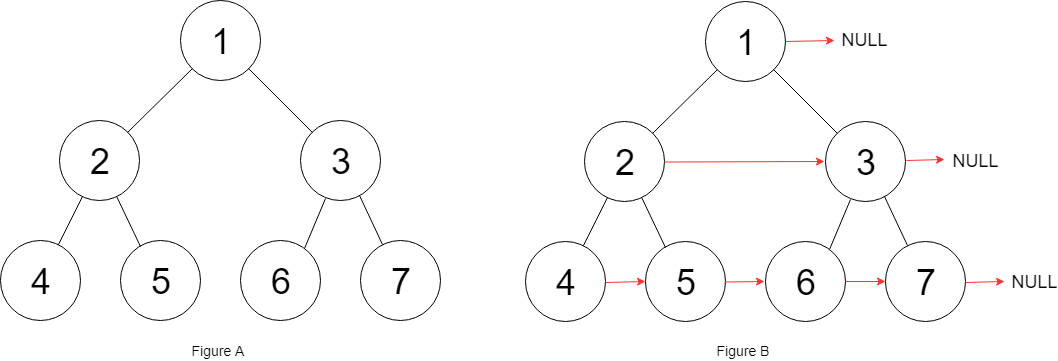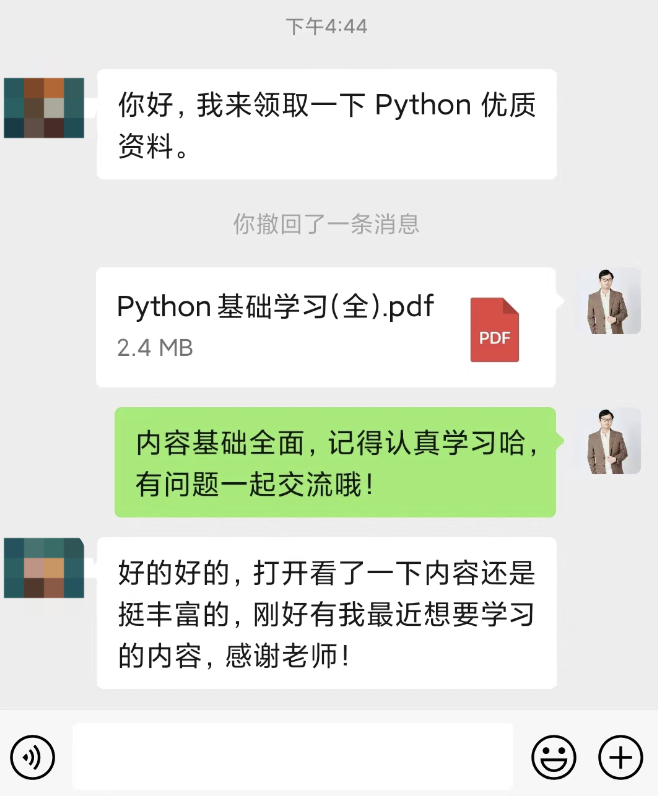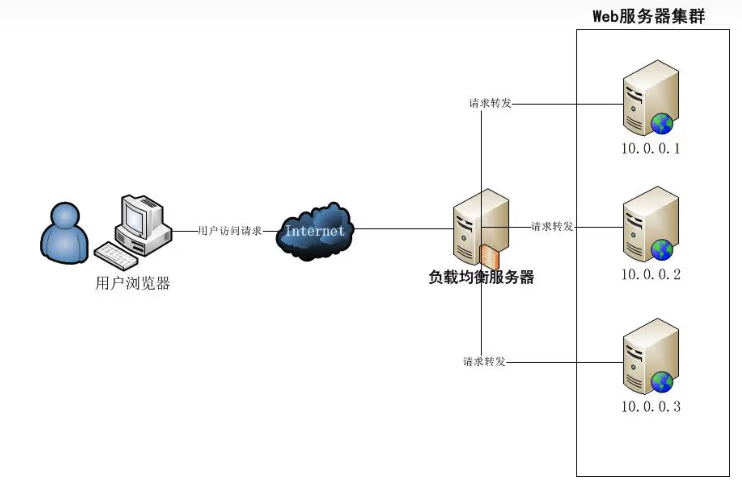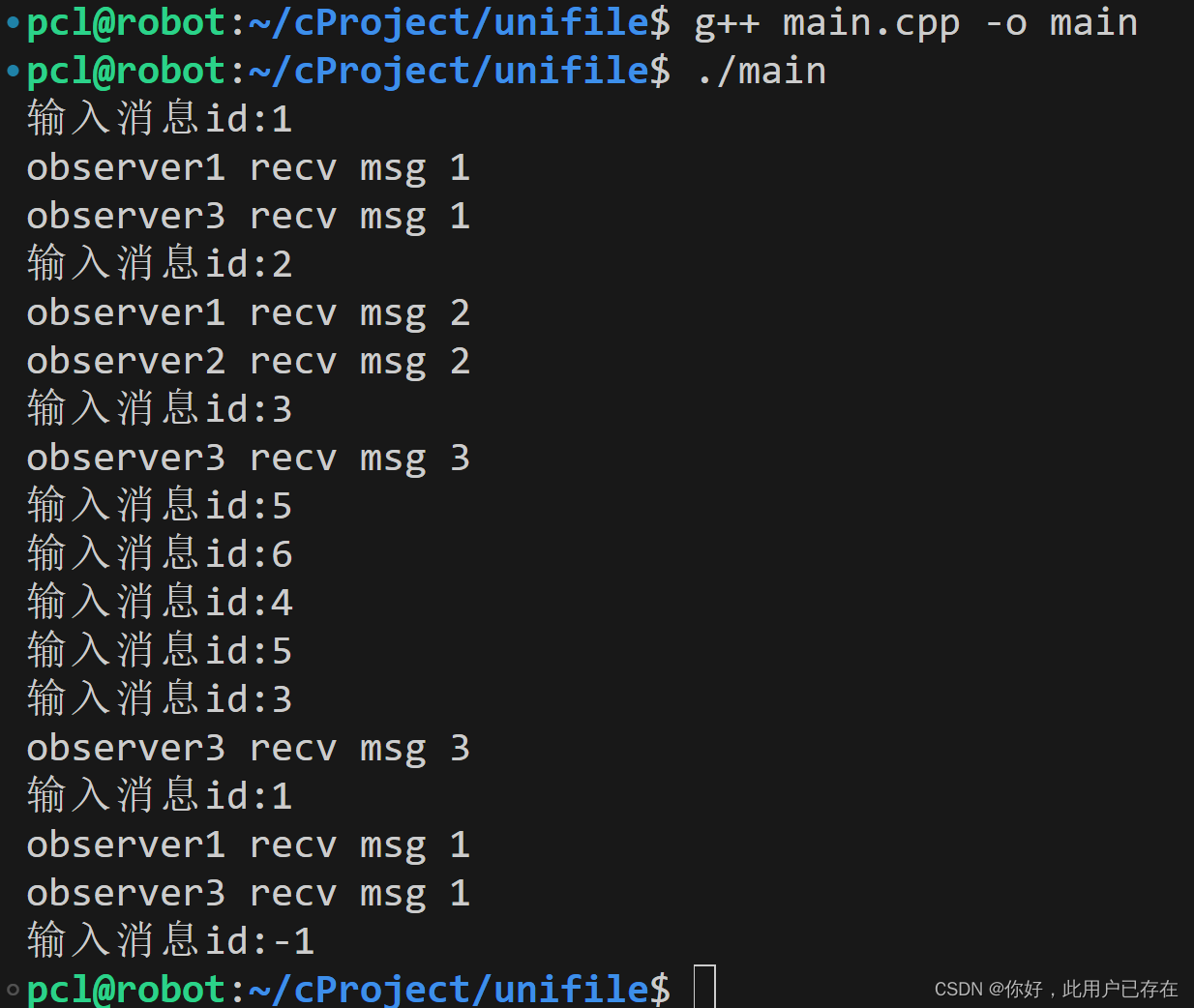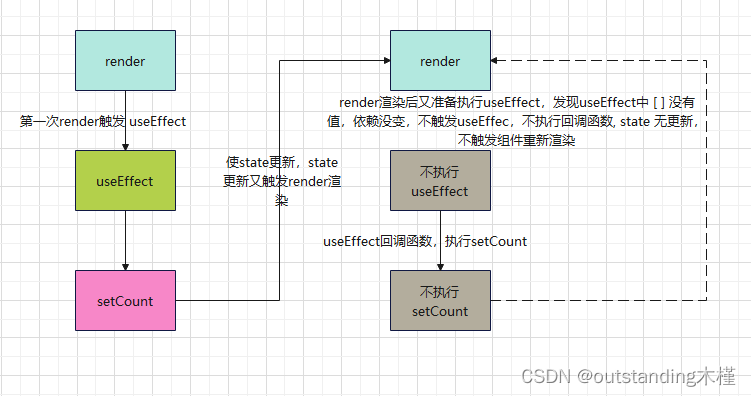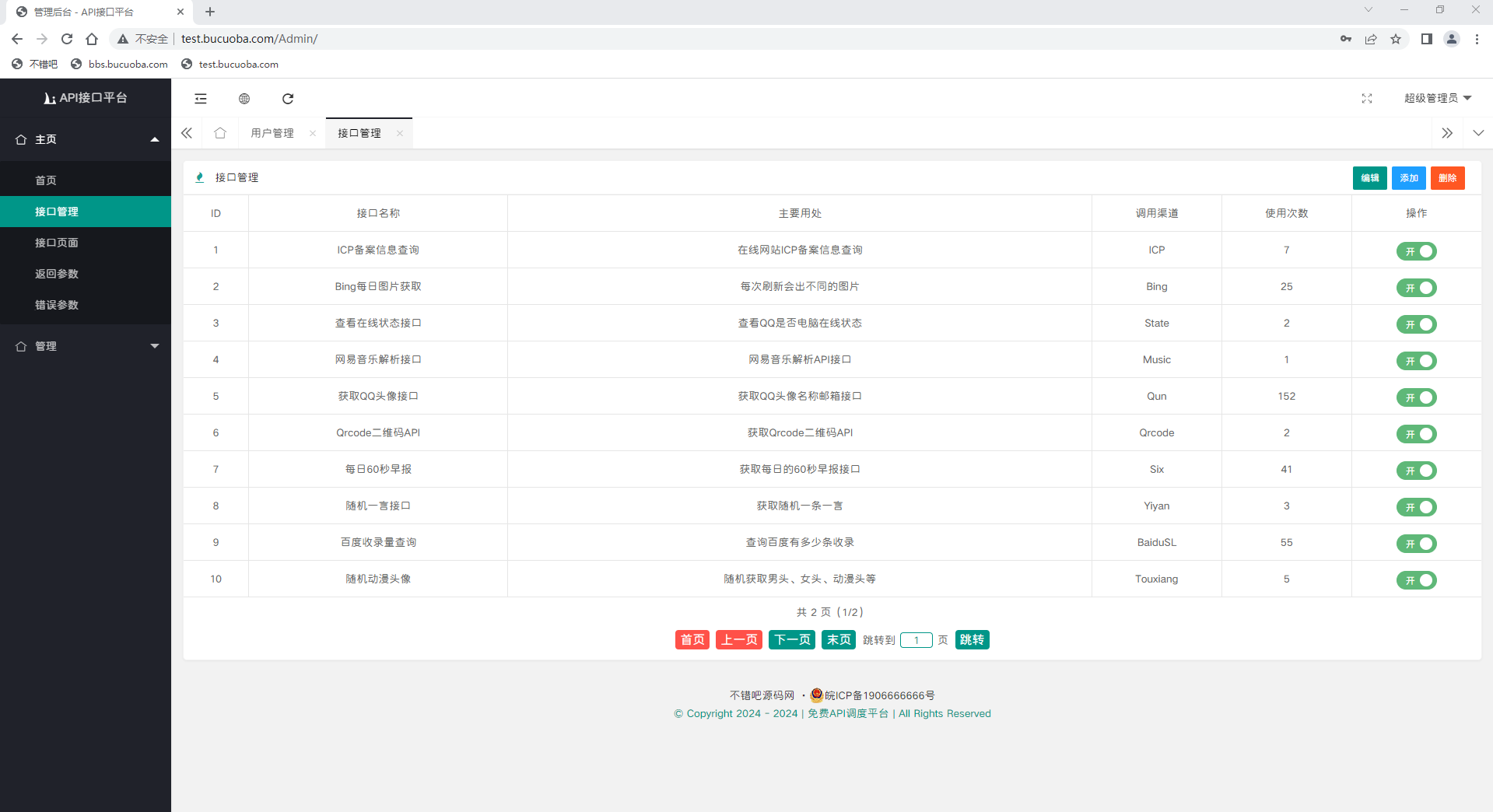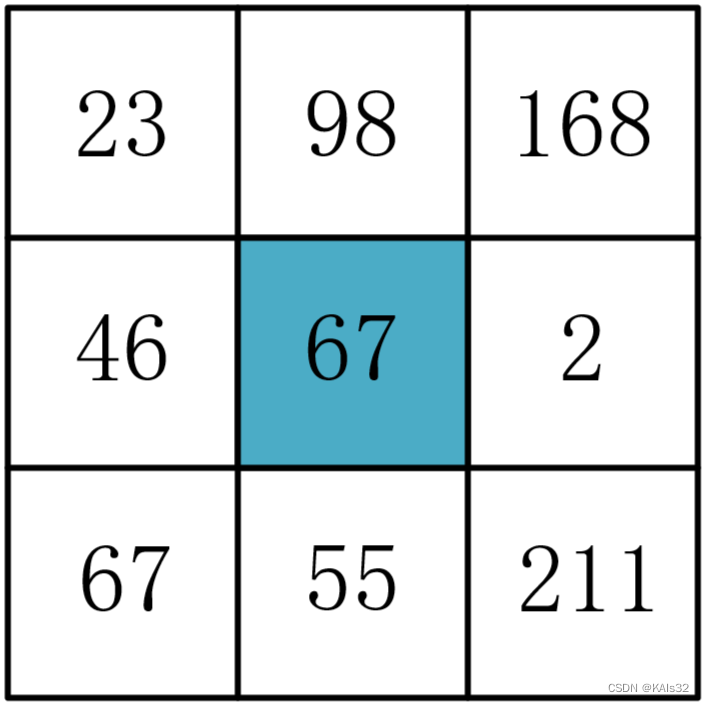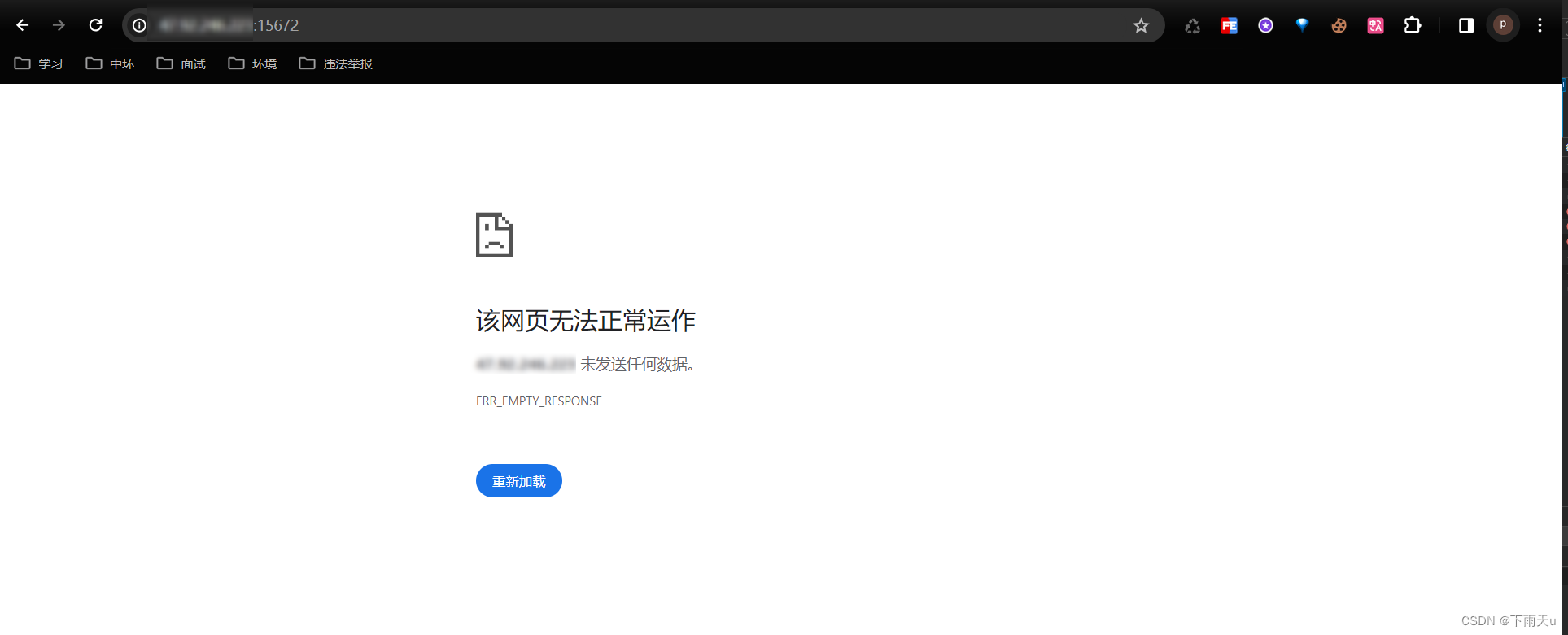STM32存储左右互搏 QSPI总线读写FLASH W25QXX
FLASH是常用的一种非易失存储单元,W25QXX系列Flash有不同容量的型号,如W25Q64的容量为64Mbit,也就是8MByte。这里介绍STM32CUBEIDE开发平台HAL库Qual SPI总线操作W25Q各型号FLASH的例程。
W25QXX介绍
W25QXX的SOIC封装如下所示,在采用QUAL SPI而不是SPI时,管脚定义为:
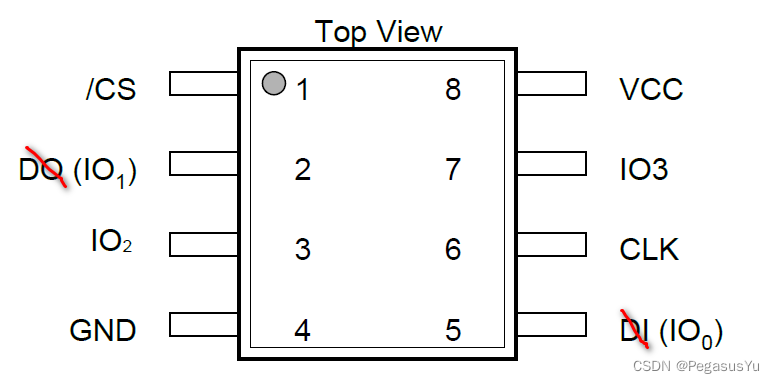
即由片选(/CS), 时钟(CLK), 双向4根输入输出线(IO0, IO1, IO2, IO3)组成6线QSPI信号接口。VCC和GND提供电源和接地连接。
例程采用STM32H750VBT6芯片, FLASH可以选择为8/16/32/64/128/256/512/1024 Mbit的W25Q型号。
STM32工程配置
首先建立基本工程并设置时钟:
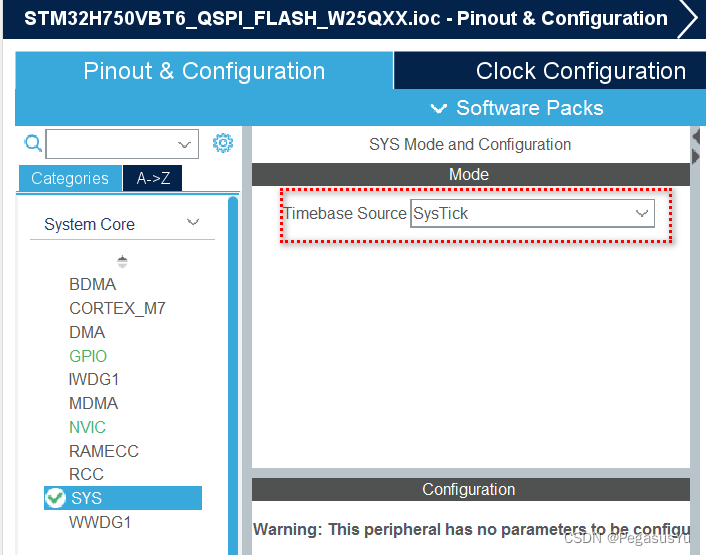
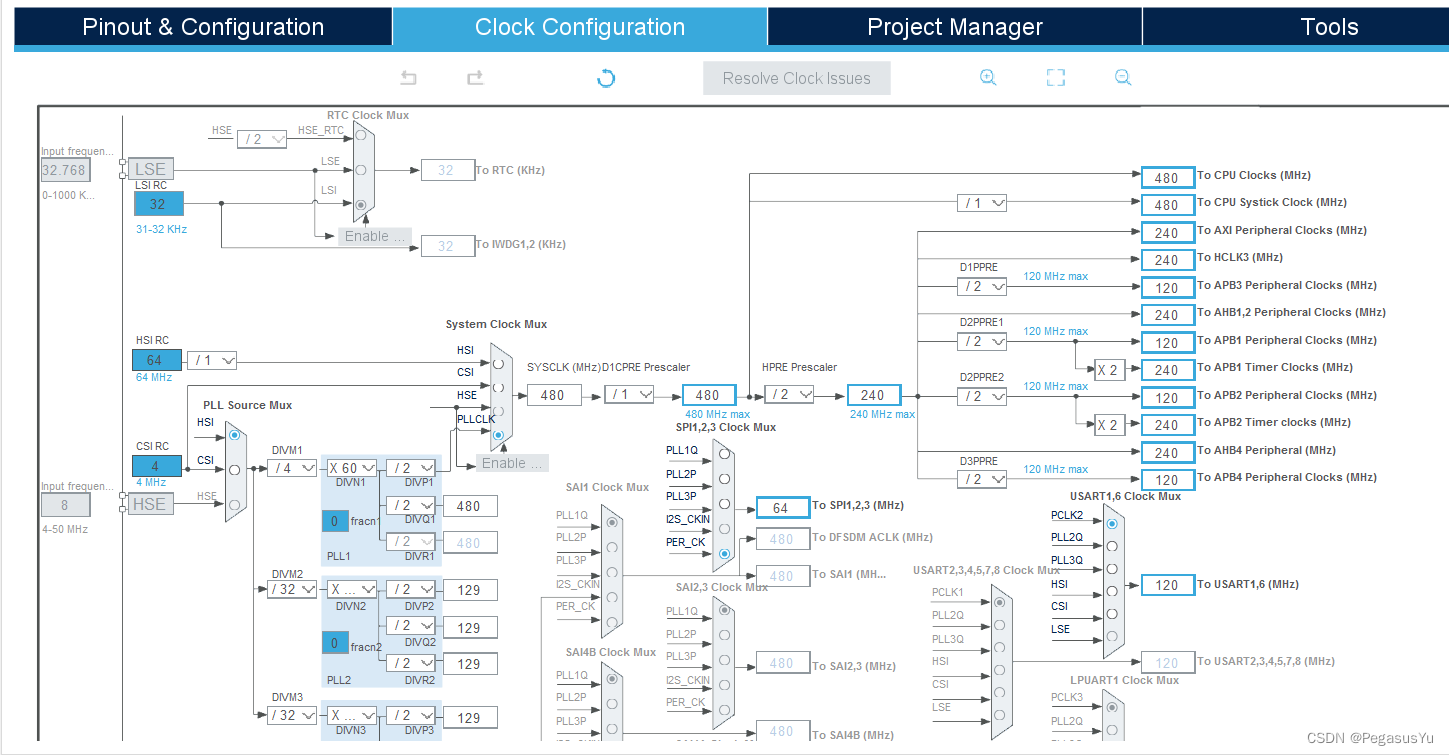
注意QSPI时钟在单独的时钟树支上:
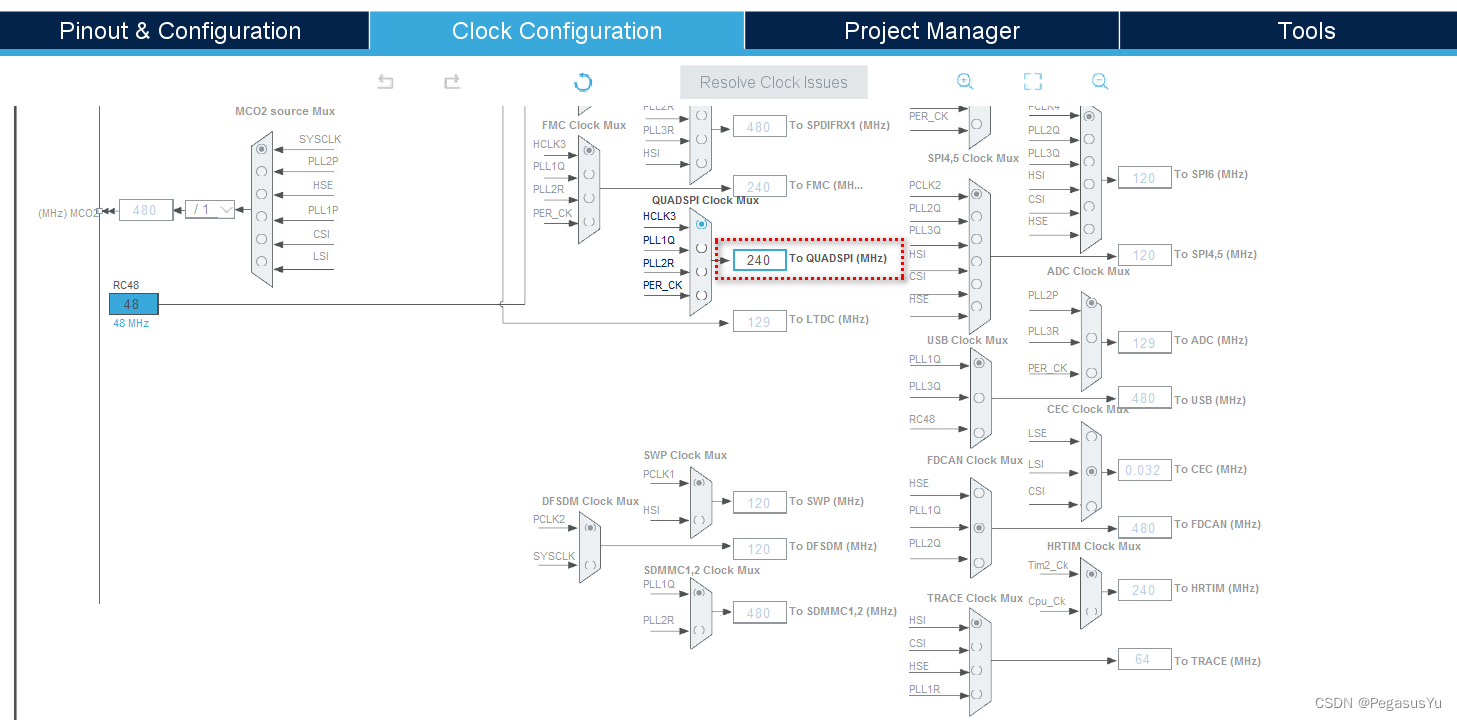
QSPI接口可以配置为两个Bank(并行协同存储扩展),也可以配置为单个Bank,并且可以由4线(数据线)模式降级为单线/双线(数据线)模式。这里对于单个Flash,选择一个bank配置:


注意QSPI的片选信号是硬件自动控制,和SPI可以采用软件代码控制不同,所以不必单独指定一个GPIO作为片选:
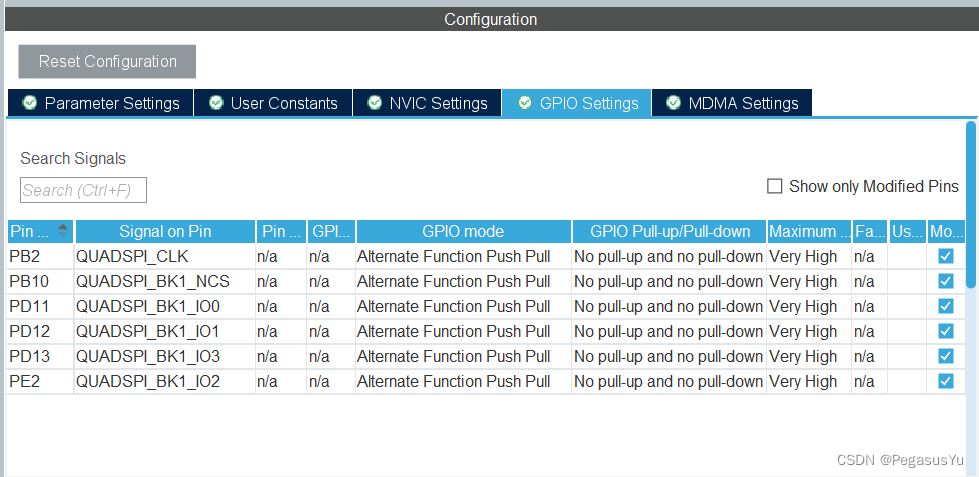
不用DMA

配置串口UART1作为命令输入和打印输出接口:
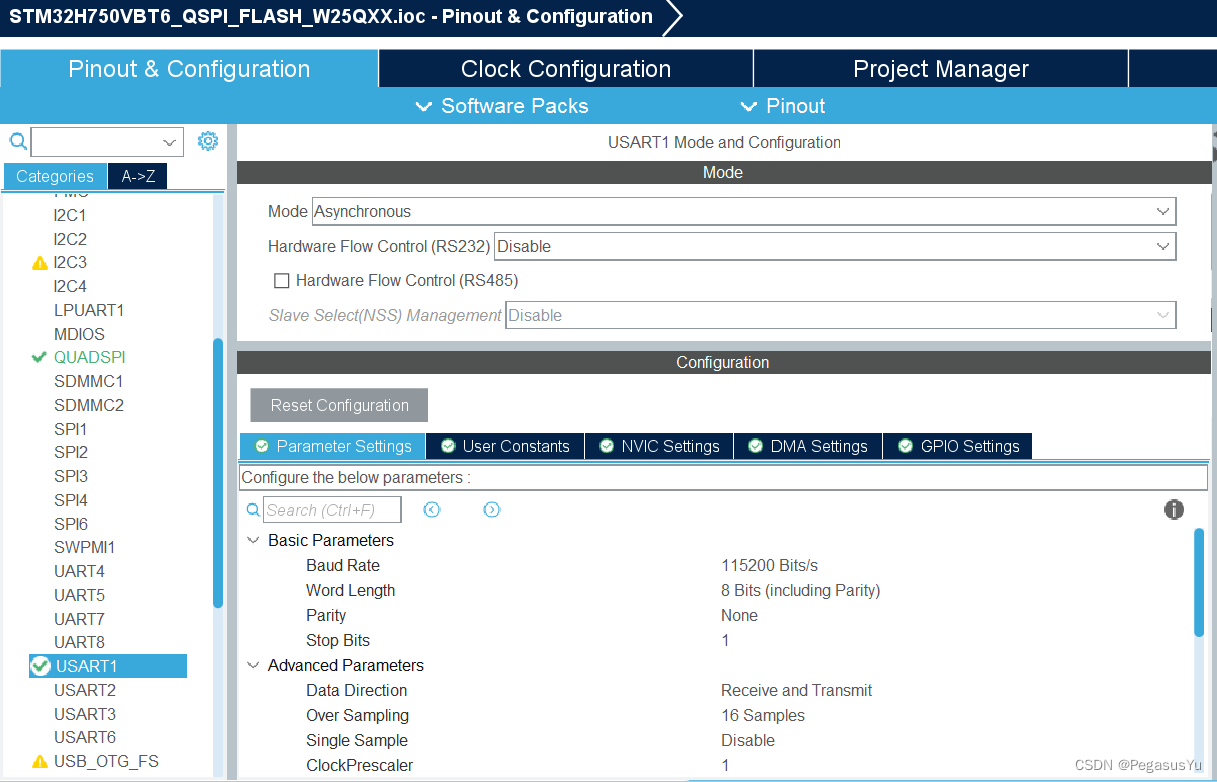
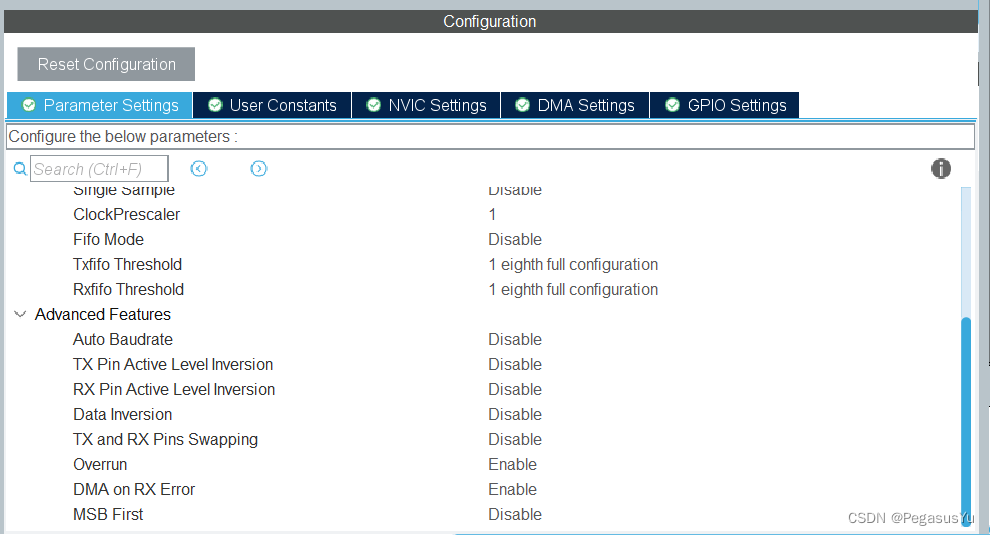

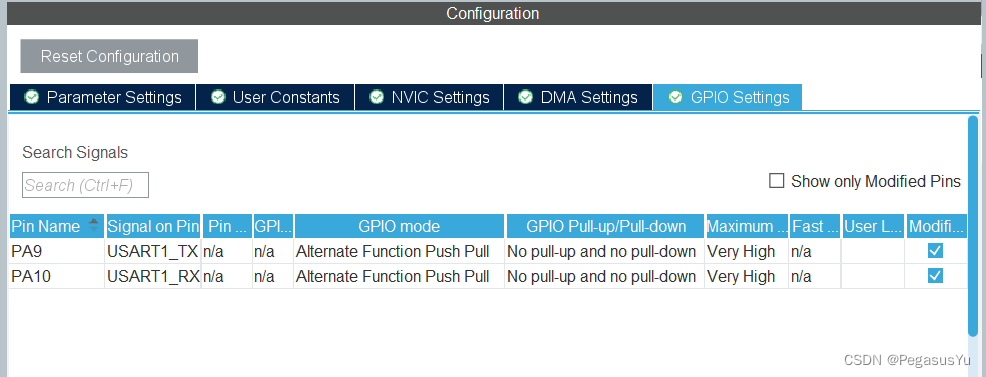
不用DMA:
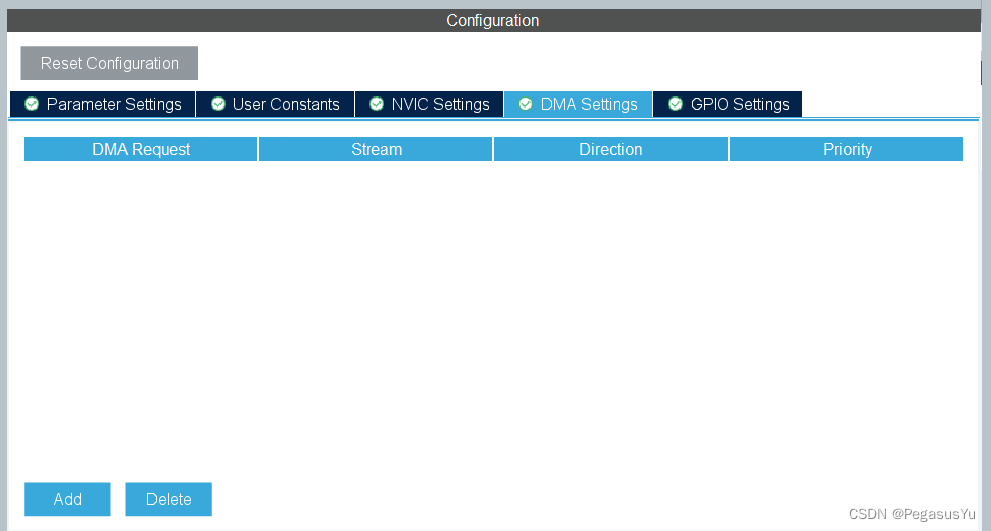
保存并生成初始工程代码:
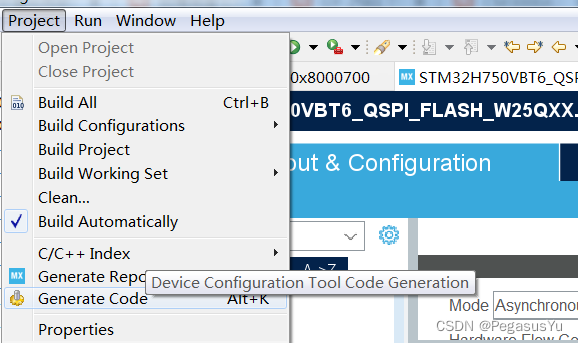
STM32工程代码
UART串口printf打印输出实现参考:STM32 UART串口printf函数应用及浮点打印代码空间节省 (HAL)
建立W25Q访问的库头文件W25QXX_QSPI.h:*
#ifndef INC_W25QXX_H_
#define INC_W25QXX_H_
#include "main.h"
//W25QXX serial chip list:
#define W25Q80_ID 0XEF13
#define W25Q16_ID 0XEF14
#define W25Q32_ID 0XEF15
#define W25Q64_ID 0XEF16
#define W25Q128_ID 0XEF17
#define W25Q256_ID 0XEF18
#define W25Q512_ID 0XEF19
#define W25Q1024_ID 0XEF20
extern uint16_t W25QXX_TYPE; //To indicate W25QXX type used in this procedure
//command table for W25QXX access
#define W25X_WriteEnable 0x06
#define W25X_WriteDisable 0x04
#define W25X_ReadStatusReg1 0x05
#define W25X_ReadStatusReg2 0x35
#define W25X_ReadStatusReg3 0x15
#define W25X_WriteStatusReg1 0x01
#define W25X_WriteStatusReg2 0x31
#define W25X_WriteStatusReg3 0x11
#define W25X_ReadData 0x03
#define W25X_FastReadData 0x0B
#define W25X_FastReadDual 0x3B
#define W25X_PageProgram 0x02
#define W25X_BlockErase 0xD8
#define W25X_SectorErase 0x20
#define W25X_ChipErase 0xC7
#define W25X_PowerDown 0xB9
#define W25X_ReleasePowerDown 0xAB
#define W25X_DeviceID 0xAB
#define W25X_ManufactDeviceID 0x90
#define W25X_JedecDeviceID 0x9F
#define W25X_Enable4ByteAddr 0xB7
#define W25X_Exit4ByteAddr 0xE9
#define W25X_QUAD_QuadInputPageProgram 0x32
#define W25X_QUAD_FastReadQuadOutput 0x6B
#define W25X_QUAD_ManufactDeviceID 0x94
#define W25X_QUAD_FastRead 0xEB
#define W25X_QUAD_SetBurstwithWrap 0x77
uint8_t W25QXX_Init(void);
uint16_t W25QXX_ReadID(void); //Read W25QXX ID
uint8_t W25QXX_ReadSR(uint8_t reg_num); //Read from status register
void W25QXX_4ByteAddr_Enable(void); //Enable 4-byte address mode
void W25QXX_Write_SR(uint8_t reg_num,uint8_t d); //Write to status register
void W25QXX_Write_Enable(void); //Write enable
void W25QXX_Write_Disable(void); //Write disable
void W25QXX_Write_NoCheck(uint8_t* pBuffer,uint32_t WriteAddr,uint16_t NumByteToWrite); //Write operation w/o check
void W25QXX_Read(uint8_t* pBuffer,uint32_t ReadAddr,uint16_t NumByteToRead); //Read operation
void W25QXX_Write(uint8_t* pBuffer,uint32_t WriteAddr,uint16_t NumByteToWrite); //Write operation
void W25QXX_Erase_Chip(void); //Erase whole chip
void W25QXX_Erase_Sector(uint32_t Sector_Num); //Erase sector in specific sector number
void W25QXX_Wait_Busy(void); //Wait idle status before next operation
void W25QXX_PowerDown(void); //Enter power-down mode
void W25QXX_WAKEUP(void); //Wake-up
#endif /* INC_W25QXX_H_ */
建立W25Q访问的库源文件W25QXX_QSPI.c:
#include "W25QXX_QSPI.h"
extern QSPI_HandleTypeDef hqspi;
extern void PY_Delay_us_t(uint32_t Delay);
extern HAL_StatusTypeDef QSPI_Send_CMD(uint8_t cmd,uint32_t addr,uint8_t mode,uint8_t dmcycle);
extern HAL_StatusTypeDef QSPI_Receive(uint8_t* buf,uint32_t datalen);
extern HAL_StatusTypeDef QSPI_Transmit(uint8_t* buf,uint32_t datalen);
#define Use_Quad_Line 1
uint16_t W25QXX_TYPE=W25Q64_ID;
//W25QXX initialization
uint8_t W25QXX_Init(void)
{
uint8_t temp;
W25QXX_TYPE=W25QXX_ReadID();
if((W25QXX_TYPE==W25Q256_ID)||(W25QXX_TYPE==W25Q512_ID)||(W25QXX_TYPE==W25Q1024_ID))
{
temp=W25QXX_ReadSR(3); //read status register 3
if((temp&0X01)==0) //judge address mode and configure to 4-byte address mode
{
QSPI_Send_CMD(W25X_Enable4ByteAddr, 0x00, (0<<6)|(0<<4)|(0<<2)|(1<<0), 0);
}
}
if((W25QXX_TYPE==0x0000)||(W25QXX_TYPE==0xFFFF)) return 0;
else return 1;
}
//Read status registers of W25QXX
//reg_num: register number from 1 to 3
//return: value of selected register
//SR1 (default 0x00):
//BIT7 6 5 4 3 2 1 0
//SPR RV TB BP2 BP1 BP0 WEL BUSY
//SPR: default 0, status register protection bit used with WP
//TB,BP2,BP1,BP0: FLASH region write protection configuration
//WEL: write enable lock
//BUSY: busy flag (1: busy; 0: idle)
//SR2:
//BIT7 6 5 4 3 2 1 0
//SUS CMP LB3 LB2 LB1 (R) QE SRP1
//SR3:
//BIT7 6 5 4 3 2 1 0
//HOLD/RST DRV1 DRV0 (R) (R) WPS ADP ADS
uint8_t W25QXX_ReadSR(uint8_t reg_num)
{
uint8_t byte=0,command=0;
switch(reg_num)
{
case 1:
command=W25X_ReadStatusReg1; //To read status register 1
break;
case 2:
command=W25X_ReadStatusReg2; //To read status register 2
break;
case 3:
command=W25X_ReadStatusReg3; //To read status register 3
break;
default:
command=W25X_ReadStatusReg1;
break;
}
QSPI_Send_CMD(command, 0x00, (1<<6)|(0<<4)|(0<<2)|(1<<0), 0); //send command
QSPI_Receive(&byte,1); //read data
return byte;
}
//Write status registers of W25QXX
//reg_num: register number from 1 to 3
//d: data for updating status register
void W25QXX_Write_SR(uint8_t reg_num,uint8_t d)
{
uint8_t command=0;
switch(reg_num)
{
case 1:
command=W25X_WriteStatusReg1; //To write status register 1
break;
case 2:
command=W25X_WriteStatusReg2; //To write status register 2
break;
case 3:
command=W25X_WriteStatusReg3; //To write status register 3
break;
default:
command=W25X_WriteStatusReg1;
break;
}
QSPI_Send_CMD(command, 0x00, (1<<6)|(0<<4)|(0<<2)|(1<<0), 0); //send command
QSPI_Transmit(&d, 1); //write data
}
//W25QXX write enable
void W25QXX_Write_Enable(void)
{
QSPI_Send_CMD(W25X_WriteEnable, 0x00, (0<<6)|(0<<4)|(0<<2)|(1<<0), 0); //send command
}
//W25QXX write disable
void W25QXX_Write_Disable(void)
{
QSPI_Send_CMD(W25X_WriteDisable, 0x00, (0<<6)|(0<<4)|(0<<2)|(1<<0), 0); //send command
}
//Read chip ID
//return:
//0XEF13 for W25Q80
//0XEF14 for W25Q16
//0XEF15 for W25Q32
//0XEF16 for W25Q64
//0XEF17 for W25Q128
//0XEF18 for W25Q256
uint16_t W25QXX_ReadID(void)
{
uint16_t Temp = 0;
uint8_t st;
uint8_t TD[8];
if(Use_Quad_Line)
{
uint8_t extra_dummy = 4; //Adjust dummy here for I/O direction adjustment delay
QSPI_Send_CMD(W25X_QUAD_ManufactDeviceID, 0x000000f0, (3<<6)|(3<<4)|(3<<2)|(1<<0), extra_dummy); ///To read Manufacturer/Device ID in Quad mode
st = QSPI_Receive(TD, 2);
if(st==0)
{
Temp = (TD[0]<<8)|TD[1];
}
else
{
Temp = 0;
}
return Temp;
}
else
{
QSPI_Send_CMD(W25X_ManufactDeviceID, 0x00, (1<<6)|(0<<4)|(0<<2)|(1<<0), 0); //To read Manufacturer/Device ID in single line mode
st = QSPI_Receive(TD, 5);
if(st==0)
{
Temp = (TD[3]<<8)|TD[4];
}
else
{
Temp = 0;
}
return Temp;
}
}
//Read W25QXX from specific address for specific byte length
//pBuffer: data buffer
//ReadAddr: specific address
//NumByteToRead: specific byte length (max 65535)
void W25QXX_Read(uint8_t* pBuffer,uint32_t ReadAddr,uint16_t NumByteToRead)
{
if(Use_Quad_Line)
{
uint8_t extra_dummy = 8; //Adjust dummy here for I/O direction adjustment delay
if((W25QXX_TYPE==W25Q256_ID)||(W25QXX_TYPE==W25Q512_ID)||(W25QXX_TYPE==W25Q1024_ID))
{
QSPI_Send_CMD(W25X_QUAD_FastReadQuadOutput, ReadAddr, (3<<6)|(3<<4)|(1<<2)|(1<<0), extra_dummy);
}
else
{
QSPI_Send_CMD(W25X_QUAD_FastReadQuadOutput, ReadAddr, (3<<6)|(2<<4)|(1<<2)|(1<<0), extra_dummy);
}
QSPI_Receive(pBuffer, NumByteToRead); //read data
}
else
{
uint8_t extra_dummy = 8; //Adjust dummy here for I/O direction adjustment delay
if((W25QXX_TYPE==W25Q256_ID)||(W25QXX_TYPE==W25Q512_ID)||(W25QXX_TYPE==W25Q1024_ID))
{
QSPI_Send_CMD(W25X_ReadData, ReadAddr, (1<<6)|(3<<4)|(1<<2)|(1<<0), extra_dummy);
}
else
{
QSPI_Send_CMD(W25X_ReadData, ReadAddr, (1<<6)|(2<<4)|(1<<2)|(1<<0), extra_dummy);
}
QSPI_Receive(pBuffer, NumByteToRead); //read data
}
}
//Write W25QXX not more than 1 page (256 bytes)
//pBuffer: data buffer
//WriteAddr: specific address
//NumByteToWrite: specific byte length (max 256)
void W25QXX_Write_Page(uint8_t* pBuffer,uint32_t WriteAddr,uint16_t NumByteToWrite)
{
W25QXX_Write_Enable(); //write enable
//send write command
if(Use_Quad_Line)
{
if((W25QXX_TYPE==W25Q256_ID)||(W25QXX_TYPE==W25Q512_ID)||(W25QXX_TYPE==W25Q1024_ID))
{
QSPI_Send_CMD(W25X_QUAD_QuadInputPageProgram, WriteAddr, (3<<6)|(3<<4)|(1<<2)|(1<<0), 0);
}
else
{
QSPI_Send_CMD(W25X_QUAD_QuadInputPageProgram, WriteAddr, (3<<6)|(2<<4)|(1<<2)|(1<<0), 0);
}
}
else
{
if((W25QXX_TYPE==W25Q256_ID)||(W25QXX_TYPE==W25Q512_ID)||(W25QXX_TYPE==W25Q1024_ID))
{
QSPI_Send_CMD(W25X_PageProgram, WriteAddr, (1<<6)|(3<<4)|(1<<2)|(1<<0), 0);
}
else
{
QSPI_Send_CMD(W25X_PageProgram, WriteAddr, (1<<6)|(2<<4)|(1<<2)|(1<<0), 0);
}
}
QSPI_Transmit(pBuffer, NumByteToWrite); //write data
W25QXX_Wait_Busy();
}
//Write W25QXX w/o erase check and w/o byte number restriction
//pBuffer: data buffer
//WriteAddr: specific address
//NumByteToWrite: specific byte length (max 65535)
void W25QXX_Write_NoCheck(uint8_t* pBuffer,uint32_t WriteAddr,uint16_t NumByteToWrite)
{
uint16_t remained_byte_num_in_page;
remained_byte_num_in_page=256-WriteAddr%256; //remained byte number in page
if( NumByteToWrite <= remained_byte_num_in_page ) remained_byte_num_in_page = NumByteToWrite; //data can be written in single page
while(1)
{
W25QXX_Write_Page(pBuffer,WriteAddr,remained_byte_num_in_page);
if(NumByteToWrite==remained_byte_num_in_page)break; //end write operation
else //NumByteToWrite>remained_byte_num_in_page
{
pBuffer+=remained_byte_num_in_page;
WriteAddr+=remained_byte_num_in_page;
NumByteToWrite-=remained_byte_num_in_page;
if(NumByteToWrite>256) remained_byte_num_in_page=256; //for whole page write
else remained_byte_num_in_page=NumByteToWrite; //for non-whole page write
}
};
}
//Write W25QXX w/ erase after check and w/o byte number restriction
//pBuffer: data buffer
//WriteAddr: specific address
//NumByteToWrite: specific byte length (max 65535)
uint8_t W25QXX_BUFFER[4096];
void W25QXX_Write(uint8_t* pBuffer,uint32_t WriteAddr,uint16_t NumByteToWrite)
{
uint32_t secpos;
uint16_t secoff;
uint16_t secremain;
uint16_t i;
uint8_t * W25QXX_BUF;
W25QXX_BUF=W25QXX_BUFFER;
secpos=WriteAddr/4096; //sector number (16 pages for 1 sector) for destination address
secoff=WriteAddr%4096; //offset address in sector for destination address
secremain=4096-secoff; //remained space for sector
if(NumByteToWrite<=secremain)secremain=NumByteToWrite; //data can be written in single sector
while(1)
{
W25QXX_Read(W25QXX_BUF,secpos*4096,4096); //read sector data for ease necessity judgment
for(i=0;i<secremain;i++) //check sector data status
{
if(W25QXX_BUF[secoff+i]!=0XFF) break; //ease necessary
}
if(i<secremain) //for ease
{
W25QXX_Erase_Sector(secpos); //ease sector
for(i=0;i<secremain;i++) //data copy
{
W25QXX_BUF[i+secoff]=pBuffer[i];
}
W25QXX_Write_NoCheck(W25QXX_BUF,secpos*4096,4096); //write sector
}
else W25QXX_Write_NoCheck(pBuffer,WriteAddr,secremain); //write data for sector unnecessary to erase
if(NumByteToWrite==secremain)break; //for operation end
else //for operation continuing
{
secpos++; //sector number + 1
secoff=0; //offset address from 0
pBuffer+=secremain; //pointer adjustment
WriteAddr+=secremain; //write address adjustment
NumByteToWrite-=secremain; //write number adjustment
if(NumByteToWrite>4096) secremain=4096; //not last sector
else secremain=NumByteToWrite; //last sector
}
};
}
//Erase whole chip, long waiting...
void W25QXX_Erase_Chip(void)
{
W25QXX_Write_Enable(); //write enable
W25QXX_Wait_Busy();
QSPI_Send_CMD(W25X_ChipErase, 0x00, (0<<6)|(0<<4)|(0<<2)|(1<<0), 0); //send erase command
W25QXX_Wait_Busy(); //wait for erase complete
}
//Erase one sector
//Sector_Num: sector number
void W25QXX_Erase_Sector(uint32_t Sector_Num)
{
Sector_Num *= 4096;
W25QXX_Write_Enable(); //write enable
W25QXX_Wait_Busy();
if((W25QXX_TYPE==W25Q256_ID)||(W25QXX_TYPE==W25Q512_ID)||(W25QXX_TYPE==W25Q1024_ID)) //send highest 8-bit address
{
QSPI_Send_CMD(W25X_SectorErase, Sector_Num, (0<<6)|(3<<4)|(1<<2)|(1<<0), 0); //send erase command
}
else
{
QSPI_Send_CMD(W25X_SectorErase, Sector_Num, (0<<6)|(2<<4)|(1<<2)|(1<<0), 0); //send erase command
}
W25QXX_Wait_Busy(); //wait for erase complete
}
//Wait idle status before next operation
void W25QXX_Wait_Busy(void)
{
while((W25QXX_ReadSR(1)&0x01)==0x01); //wait for busy flag cleared
}
//Enter power-down mode
#define tDP_us 3
void W25QXX_PowerDown(void)
{
QSPI_Send_CMD(W25X_PowerDown, 0, (0<<6)|(0<<4)|(0<<2)|(1<<0), 0); //send power-down command
PY_Delay_us_t(tDP_us); //tDP
}
//Wake-up
#define tRES1_us 3
void W25QXX_WAKEUP(void)
{
QSPI_Send_CMD(W25X_ReleasePowerDown, 0, (0<<6)|(0<<4)|(0<<2)|(1<<0), 0); //send release power-down command
PY_Delay_us_t(tRES1_us); //tRES1
}
main.c文件操作代码里包含几个QSPI操作函数定义如下:
#define page_byte_size 256
uint8_t sdbuffer[page_byte_size];
/*
QSPI TX in block mode for command byte
cmd: command to be sent to device
addr: address to be sent to device
mode: operation mode set as
mode[1:0] for command transmission mode ( 00: no command; 01: single-line transmission; 10: dual-line transmission; 11: four-line transmission )
mode[3:2] for address transmission mode ( 00: no address; 01: single-line transmission; 10: dual-line transmission; 11: four-line transmission )
mode[5:4] for address length ( 00:8-bit address; 01: 16-bit address; 10: 24-bit address; 11: 32-bit address )
mode[7:6] for data transmission mode ( 00: no command; 01: single-line transmission; 10: dual-line transmission; 11: four-line transmission )
dmcycle: dummy clock cycle
*/
HAL_StatusTypeDef QSPI_Send_CMD(uint8_t cmd,uint32_t addr,uint8_t mode,uint8_t dmcycle)
{
QSPI_CommandTypeDef Cmdhandler;
Cmdhandler.Instruction=cmd; //set cmd
Cmdhandler.Address=addr; //set address
Cmdhandler.DummyCycles=dmcycle; //set dummy circle number
/*set cmd transmission mode*/
if(((mode>>0)&0x03) == 0)
Cmdhandler.InstructionMode=QSPI_INSTRUCTION_NONE;
else if(((mode>>0)&0x03) == 1)
Cmdhandler.InstructionMode=QSPI_INSTRUCTION_1_LINE;
else if(((mode>>0)&0x03) == 2)
Cmdhandler.InstructionMode=QSPI_INSTRUCTION_2_LINES;
else if(((mode>>0)&0x03) == 3)
Cmdhandler.InstructionMode=QSPI_INSTRUCTION_4_LINES;
/*set address transmission mode*/
if(((mode>>2)&0x03) == 0)
Cmdhandler.AddressMode=QSPI_ADDRESS_NONE;
else if(((mode>>2)&0x03) == 1)
Cmdhandler.AddressMode=QSPI_ADDRESS_1_LINE;
else if(((mode>>2)&0x03) == 2)
Cmdhandler.AddressMode=QSPI_ADDRESS_2_LINES;
else if(((mode>>2)&0x03) == 3)
Cmdhandler.AddressMode=QSPI_ADDRESS_4_LINES;
/*set address length*/
if(((mode>>4)&0x03) == 0)
Cmdhandler.AddressSize=QSPI_ADDRESS_8_BITS;
else if(((mode>>4)&0x03) == 1)
Cmdhandler.AddressSize=QSPI_ADDRESS_16_BITS;
else if(((mode>>4)&0x03) == 2)
Cmdhandler.AddressSize=QSPI_ADDRESS_24_BITS;
else if(((mode>>4)&0x03) == 3)
Cmdhandler.AddressSize=QSPI_ADDRESS_32_BITS;
/*set data transmission mode*/
if(((mode>>6)&0x03) == 0)
Cmdhandler.DataMode=QSPI_DATA_NONE;
else if(((mode>>6)&0x03) == 1)
Cmdhandler.DataMode=QSPI_DATA_1_LINE;
else if(((mode>>6)&0x03) == 2)
Cmdhandler.DataMode=QSPI_DATA_2_LINES;
else if(((mode>>6)&0x03) == 3)
Cmdhandler.DataMode=QSPI_DATA_4_LINES;
Cmdhandler.SIOOMode=QSPI_SIOO_INST_EVERY_CMD; /*Send instruction on every transaction*/
Cmdhandler.AlternateByteMode=QSPI_ALTERNATE_BYTES_NONE; /*No alternate bytes*/
Cmdhandler.DdrMode=QSPI_DDR_MODE_DISABLE; /*Double data rate mode disabled*/
Cmdhandler.DdrHoldHalfCycle=QSPI_DDR_HHC_ANALOG_DELAY; /*Delay the data output using analog delay in DDR mode*/
return HAL_QSPI_Command(&hqspi,&Cmdhandler,5000);
}
//QSPI RX in block mode for data
//buf : buffer address for RX data
//datalen : RX data length
//return : 0, OK
// others, error code
HAL_StatusTypeDef QSPI_Receive(uint8_t* buf,uint32_t datalen)
{
hqspi.Instance->DLR=datalen-1;
return HAL_QSPI_Receive(&hqspi,buf,5000);
}
//QSPI TX in block mode for data
//buf : buffer address for TX data
//datalen : TX data length
//return : 0, OK
// others, error code
HAL_StatusTypeDef QSPI_Transmit(uint8_t* buf,uint32_t datalen)
{
hqspi.Instance->DLR=datalen-1;
return HAL_QSPI_Transmit(&hqspi,buf,5000);
}
main.c文件操作代码里实现串口接收1个字节的指令,实现FLASH的ID读取,一页的写入,一页的读出三个功能。其它功能可以根据需要自行增加。完整的main.c文件如下:
/* USER CODE BEGIN Header */
/**
******************************************************************************
* @file : main.c
* @brief : Main program body
******************************************************************************
* @attention
*
* Copyright (c) 2023 STMicroelectronics.
* All rights reserved.
*
* This software is licensed under terms that can be found in the LICENSE file
* in the root directory of this software component.
* If no LICENSE file comes with this software, it is provided AS-IS.
*
******************************************************************************
*/
//Written by Pegasus Yu in 2023
//NOte: to access W25Qxx, send single line command at first to trigger consequent operation mode for address and data which could be 1-line or 4-line
/* USER CODE END Header */
/* Includes ------------------------------------------------------------------*/
#include "main.h"
/* Private includes ----------------------------------------------------------*/
/* USER CODE BEGIN Includes */
#include <string.h>
#include "usart.h"
#include "W25QXX_QSPI.h"
/* USER CODE END Includes */
/* Private typedef -----------------------------------------------------------*/
/* USER CODE BEGIN PTD */
__IO float usDelayBase;
void PY_usDelayTest(void)
{
__IO uint32_t firstms, secondms;
__IO uint32_t counter = 0;
firstms = HAL_GetTick()+1;
secondms = firstms+1;
while(uwTick!=firstms) ;
while(uwTick!=secondms) counter++;
usDelayBase = ((float)counter)/1000;
}
void PY_Delay_us_t(uint32_t Delay)
{
__IO uint32_t delayReg;
__IO uint32_t usNum = (uint32_t)(Delay*usDelayBase);
delayReg = 0;
while(delayReg!=usNum) delayReg++;
}
void PY_usDelayOptimize(void)
{
__IO uint32_t firstms, secondms;
__IO float coe = 1.0;
firstms = HAL_GetTick();
PY_Delay_us_t(1000000) ;
secondms = HAL_GetTick();
coe = ((float)1000)/(secondms-firstms);
usDelayBase = coe*usDelayBase;
}
void PY_Delay_us(uint32_t Delay)
{
__IO uint32_t delayReg;
__IO uint32_t msNum = Delay/1000;
__IO uint32_t usNum = (uint32_t)((Delay%1000)*usDelayBase);
if(msNum>0) HAL_Delay(msNum);
delayReg = 0;
while(delayReg!=usNum) delayReg++;
}
/* USER CODE END PTD */
/* Private define ------------------------------------------------------------*/
/* USER CODE BEGIN PD */
/* USER CODE END PD */
/* Private macro -------------------------------------------------------------*/
/* USER CODE BEGIN PM */
/* USER CODE END PM */
/* Private variables ---------------------------------------------------------*/
QSPI_HandleTypeDef hqspi;
UART_HandleTypeDef huart1;
/* USER CODE BEGIN PV */
uint8_t uart1_rx[16];
uint8_t cmd;
uint32_t Flash_Access_Addr = 0;
uint8_t st;
uint16_t FID;
uint8_t TD[256];
/* USER CODE END PV */
/* Private function prototypes -----------------------------------------------*/
void SystemClock_Config(void);
static void MX_GPIO_Init(void);
static void MX_USART1_UART_Init(void);
static void MX_QUADSPI_Init(void);
/* USER CODE BEGIN PFP */
/* USER CODE END PFP */
/* Private user code ---------------------------------------------------------*/
/* USER CODE BEGIN 0 */
#define page_byte_size 256
uint8_t sdbuffer[page_byte_size];
/*
QSPI TX in block mode for command byte
cmd: command to be sent to device
addr: address to be sent to device
mode: operation mode set as
mode[1:0] for command transmission mode ( 00: no command; 01: single-line transmission; 10: dual-line transmission; 11: four-line transmission )
mode[3:2] for address transmission mode ( 00: no address; 01: single-line transmission; 10: dual-line transmission; 11: four-line transmission )
mode[5:4] for address length ( 00:8-bit address; 01: 16-bit address; 10: 24-bit address; 11: 32-bit address )
mode[7:6] for data transmission mode ( 00: no command; 01: single-line transmission; 10: dual-line transmission; 11: four-line transmission )
dmcycle: dummy clock cycle
*/
HAL_StatusTypeDef QSPI_Send_CMD(uint8_t cmd,uint32_t addr,uint8_t mode,uint8_t dmcycle)
{
QSPI_CommandTypeDef Cmdhandler;
Cmdhandler.Instruction=cmd; //set cmd
Cmdhandler.Address=addr; //set address
Cmdhandler.DummyCycles=dmcycle; //set dummy circle number
/*set cmd transmission mode*/
if(((mode>>0)&0x03) == 0)
Cmdhandler.InstructionMode=QSPI_INSTRUCTION_NONE;
else if(((mode>>0)&0x03) == 1)
Cmdhandler.InstructionMode=QSPI_INSTRUCTION_1_LINE;
else if(((mode>>0)&0x03) == 2)
Cmdhandler.InstructionMode=QSPI_INSTRUCTION_2_LINES;
else if(((mode>>0)&0x03) == 3)
Cmdhandler.InstructionMode=QSPI_INSTRUCTION_4_LINES;
/*set address transmission mode*/
if(((mode>>2)&0x03) == 0)
Cmdhandler.AddressMode=QSPI_ADDRESS_NONE;
else if(((mode>>2)&0x03) == 1)
Cmdhandler.AddressMode=QSPI_ADDRESS_1_LINE;
else if(((mode>>2)&0x03) == 2)
Cmdhandler.AddressMode=QSPI_ADDRESS_2_LINES;
else if(((mode>>2)&0x03) == 3)
Cmdhandler.AddressMode=QSPI_ADDRESS_4_LINES;
/*set address length*/
if(((mode>>4)&0x03) == 0)
Cmdhandler.AddressSize=QSPI_ADDRESS_8_BITS;
else if(((mode>>4)&0x03) == 1)
Cmdhandler.AddressSize=QSPI_ADDRESS_16_BITS;
else if(((mode>>4)&0x03) == 2)
Cmdhandler.AddressSize=QSPI_ADDRESS_24_BITS;
else if(((mode>>4)&0x03) == 3)
Cmdhandler.AddressSize=QSPI_ADDRESS_32_BITS;
/*set data transmission mode*/
if(((mode>>6)&0x03) == 0)
Cmdhandler.DataMode=QSPI_DATA_NONE;
else if(((mode>>6)&0x03) == 1)
Cmdhandler.DataMode=QSPI_DATA_1_LINE;
else if(((mode>>6)&0x03) == 2)
Cmdhandler.DataMode=QSPI_DATA_2_LINES;
else if(((mode>>6)&0x03) == 3)
Cmdhandler.DataMode=QSPI_DATA_4_LINES;
Cmdhandler.SIOOMode=QSPI_SIOO_INST_EVERY_CMD; /*Send instruction on every transaction*/
Cmdhandler.AlternateByteMode=QSPI_ALTERNATE_BYTES_NONE; /*No alternate bytes*/
Cmdhandler.DdrMode=QSPI_DDR_MODE_DISABLE; /*Double data rate mode disabled*/
Cmdhandler.DdrHoldHalfCycle=QSPI_DDR_HHC_ANALOG_DELAY; /*Delay the data output using analog delay in DDR mode*/
return HAL_QSPI_Command(&hqspi,&Cmdhandler,5000);
}
//QSPI RX in block mode for data
//buf : buffer address for RX data
//datalen : RX data length
//return : 0, OK
// others, error code
HAL_StatusTypeDef QSPI_Receive(uint8_t* buf,uint32_t datalen)
{
hqspi.Instance->DLR=datalen-1;
return HAL_QSPI_Receive(&hqspi,buf,5000);
}
//QSPI TX in block mode for data
//buf : buffer address for TX data
//datalen : TX data length
//return : 0, OK
// others, error code
HAL_StatusTypeDef QSPI_Transmit(uint8_t* buf,uint32_t datalen)
{
hqspi.Instance->DLR=datalen-1;
return HAL_QSPI_Transmit(&hqspi,buf,5000);
}
/* USER CODE END 0 */
/**
* @brief The application entry point.
* @retval int
*/
int main(void)
{
/* USER CODE BEGIN 1 */
/* USER CODE END 1 */
/* MCU Configuration--------------------------------------------------------*/
/* Reset of all peripherals, Initializes the Flash interface and the Systick. */
HAL_Init();
/* USER CODE BEGIN Init */
/* USER CODE END Init */
/* Configure the system clock */
SystemClock_Config();
/* USER CODE BEGIN SysInit */
/* USER CODE END SysInit */
/* Initialize all configured peripherals */
MX_GPIO_Init();
MX_USART1_UART_Init();
MX_QUADSPI_Init();
/* USER CODE BEGIN 2 */
PY_usDelayTest();
PY_usDelayOptimize();
HAL_UART_Receive_IT(&huart1, uart1_rx, 1);
W25QXX_Init();
/* USER CODE END 2 */
/* Infinite loop */
/* USER CODE BEGIN WHILE */
while (1)
{
if(cmd==0x01) //Read ID
{
cmd = 0;
FID = W25QXX_ReadID();
printf("Flash ID = 0x%x\r\n\r\n", FID);
printf("W25Q80_ID: 0XEF13\r\n");
printf("W25Q16_ID: 0XEF14\r\n");
printf("W25Q32_ID: 0XEF15\r\n");
printf("W25Q64_ID: 0XEF16\r\n");
printf("W25Q128_ID: 0XEF17\r\n");
printf("W25Q256_ID: 0XEF18\r\n");
printf("W25Q512_ID: 0XEF18\r\n");
printf("W25Q1024_ID: 0XEF20\r\n");
}
if(cmd==2) //Write one page
{
cmd = 0;
for(uint32_t i=0;i<page_byte_size;i++)
{
sdbuffer[i]=i;
}
Flash_Access_Addr = 0;
W25QXX_Write(sdbuffer, Flash_Access_Addr, page_byte_size);
printf("Write to W25QXX done!\r\n");
}
if(cmd==3)//Read one page
{
cmd = 0;
memset(sdbuffer, 0, page_byte_size);
printf("Start to read W25QXX......\r\n");
Flash_Access_Addr = 0;
W25QXX_Read(sdbuffer, Flash_Access_Addr, page_byte_size);
for(uint32_t i=0; i<page_byte_size; i++)
{
printf("%d ", sdbuffer[i]);
}
printf("\r\n");
}
/* USER CODE END WHILE */
/* USER CODE BEGIN 3 */
}
/* USER CODE END 3 */
}
/**
* @brief System Clock Configuration
* @retval None
*/
void SystemClock_Config(void)
{
RCC_OscInitTypeDef RCC_OscInitStruct = {0};
RCC_ClkInitTypeDef RCC_ClkInitStruct = {0};
/** Supply configuration update enable
*/
HAL_PWREx_ConfigSupply(PWR_LDO_SUPPLY);
/** Configure the main internal regulator output voltage
*/
__HAL_PWR_VOLTAGESCALING_CONFIG(PWR_REGULATOR_VOLTAGE_SCALE1);
while(!__HAL_PWR_GET_FLAG(PWR_FLAG_VOSRDY)) {}
__HAL_RCC_SYSCFG_CLK_ENABLE();
__HAL_PWR_VOLTAGESCALING_CONFIG(PWR_REGULATOR_VOLTAGE_SCALE0);
while(!__HAL_PWR_GET_FLAG(PWR_FLAG_VOSRDY)) {}
/** Initializes the RCC Oscillators according to the specified parameters
* in the RCC_OscInitTypeDef structure.
*/
RCC_OscInitStruct.OscillatorType = RCC_OSCILLATORTYPE_HSI;
RCC_OscInitStruct.HSIState = RCC_HSI_DIV1;
RCC_OscInitStruct.HSICalibrationValue = RCC_HSICALIBRATION_DEFAULT;
RCC_OscInitStruct.PLL.PLLState = RCC_PLL_ON;
RCC_OscInitStruct.PLL.PLLSource = RCC_PLLSOURCE_HSI;
RCC_OscInitStruct.PLL.PLLM = 4;
RCC_OscInitStruct.PLL.PLLN = 60;
RCC_OscInitStruct.PLL.PLLP = 2;
RCC_OscInitStruct.PLL.PLLQ = 2;
RCC_OscInitStruct.PLL.PLLR = 2;
RCC_OscInitStruct.PLL.PLLRGE = RCC_PLL1VCIRANGE_3;
RCC_OscInitStruct.PLL.PLLVCOSEL = RCC_PLL1VCOWIDE;
RCC_OscInitStruct.PLL.PLLFRACN = 0;
if (HAL_RCC_OscConfig(&RCC_OscInitStruct) != HAL_OK)
{
Error_Handler();
}
/** Initializes the CPU, AHB and APB buses clocks
*/
RCC_ClkInitStruct.ClockType = RCC_CLOCKTYPE_HCLK|RCC_CLOCKTYPE_SYSCLK
|RCC_CLOCKTYPE_PCLK1|RCC_CLOCKTYPE_PCLK2
|RCC_CLOCKTYPE_D3PCLK1|RCC_CLOCKTYPE_D1PCLK1;
RCC_ClkInitStruct.SYSCLKSource = RCC_SYSCLKSOURCE_PLLCLK;
RCC_ClkInitStruct.SYSCLKDivider = RCC_SYSCLK_DIV1;
RCC_ClkInitStruct.AHBCLKDivider = RCC_HCLK_DIV2;
RCC_ClkInitStruct.APB3CLKDivider = RCC_APB3_DIV2;
RCC_ClkInitStruct.APB1CLKDivider = RCC_APB1_DIV2;
RCC_ClkInitStruct.APB2CLKDivider = RCC_APB2_DIV2;
RCC_ClkInitStruct.APB4CLKDivider = RCC_APB4_DIV2;
if (HAL_RCC_ClockConfig(&RCC_ClkInitStruct, FLASH_LATENCY_4) != HAL_OK)
{
Error_Handler();
}
}
/**
* @brief QUADSPI Initialization Function
* @param None
* @retval None
*/
static void MX_QUADSPI_Init(void)
{
/* USER CODE BEGIN QUADSPI_Init 0 */
/* USER CODE END QUADSPI_Init 0 */
/* USER CODE BEGIN QUADSPI_Init 1 */
/* USER CODE END QUADSPI_Init 1 */
/* QUADSPI parameter configuration*/
hqspi.Instance = QUADSPI;
hqspi.Init.ClockPrescaler = 9;
hqspi.Init.FifoThreshold = 4;
hqspi.Init.SampleShifting = QSPI_SAMPLE_SHIFTING_HALFCYCLE;
hqspi.Init.FlashSize = 25;
hqspi.Init.ChipSelectHighTime = QSPI_CS_HIGH_TIME_5_CYCLE;
hqspi.Init.ClockMode = QSPI_CLOCK_MODE_0;
hqspi.Init.FlashID = QSPI_FLASH_ID_1;
hqspi.Init.DualFlash = QSPI_DUALFLASH_DISABLE;
if (HAL_QSPI_Init(&hqspi) != HAL_OK)
{
Error_Handler();
}
/* USER CODE BEGIN QUADSPI_Init 2 */
/* USER CODE END QUADSPI_Init 2 */
}
/**
* @brief USART1 Initialization Function
* @param None
* @retval None
*/
static void MX_USART1_UART_Init(void)
{
/* USER CODE BEGIN USART1_Init 0 */
/* USER CODE END USART1_Init 0 */
/* USER CODE BEGIN USART1_Init 1 */
/* USER CODE END USART1_Init 1 */
huart1.Instance = USART1;
huart1.Init.BaudRate = 115200;
huart1.Init.WordLength = UART_WORDLENGTH_8B;
huart1.Init.StopBits = UART_STOPBITS_1;
huart1.Init.Parity = UART_PARITY_NONE;
huart1.Init.Mode = UART_MODE_TX_RX;
huart1.Init.HwFlowCtl = UART_HWCONTROL_NONE;
huart1.Init.OverSampling = UART_OVERSAMPLING_16;
huart1.Init.OneBitSampling = UART_ONE_BIT_SAMPLE_DISABLE;
huart1.Init.ClockPrescaler = UART_PRESCALER_DIV1;
huart1.AdvancedInit.AdvFeatureInit = UART_ADVFEATURE_NO_INIT;
if (HAL_UART_Init(&huart1) != HAL_OK)
{
Error_Handler();
}
if (HAL_UARTEx_SetTxFifoThreshold(&huart1, UART_TXFIFO_THRESHOLD_1_8) != HAL_OK)
{
Error_Handler();
}
if (HAL_UARTEx_SetRxFifoThreshold(&huart1, UART_RXFIFO_THRESHOLD_1_8) != HAL_OK)
{
Error_Handler();
}
if (HAL_UARTEx_DisableFifoMode(&huart1) != HAL_OK)
{
Error_Handler();
}
/* USER CODE BEGIN USART1_Init 2 */
/* USER CODE END USART1_Init 2 */
}
/**
* @brief GPIO Initialization Function
* @param None
* @retval None
*/
static void MX_GPIO_Init(void)
{
/* GPIO Ports Clock Enable */
__HAL_RCC_GPIOE_CLK_ENABLE();
__HAL_RCC_GPIOB_CLK_ENABLE();
__HAL_RCC_GPIOD_CLK_ENABLE();
__HAL_RCC_GPIOA_CLK_ENABLE();
}
/* USER CODE BEGIN 4 */
void HAL_UART_RxCpltCallback(UART_HandleTypeDef *huart)
{
if(huart==&huart1)
{
cmd = uart1_rx[0];
HAL_UART_Receive_IT(&huart1, uart1_rx, 1);
}
}
/* USER CODE END 4 */
/**
* @brief This function is executed in case of error occurrence.
* @retval None
*/
void Error_Handler(void)
{
/* USER CODE BEGIN Error_Handler_Debug */
/* User can add his own implementation to report the HAL error return state */
__disable_irq();
while (1)
{
}
/* USER CODE END Error_Handler_Debug */
}
#ifdef USE_FULL_ASSERT
/**
* @brief Reports the name of the source file and the source line number
* where the assert_param error has occurred.
* @param file: pointer to the source file name
* @param line: assert_param error line source number
* @retval None
*/
void assert_failed(uint8_t *file, uint32_t line)
{
/* USER CODE BEGIN 6 */
/* User can add his own implementation to report the file name and line number,
ex: printf("Wrong parameters value: file %s on line %d\r\n", file, line) */
/* USER CODE END 6 */
}
#endif /* USE_FULL_ASSERT */
STM32例程测试
串口指令0x01测试效果如下:
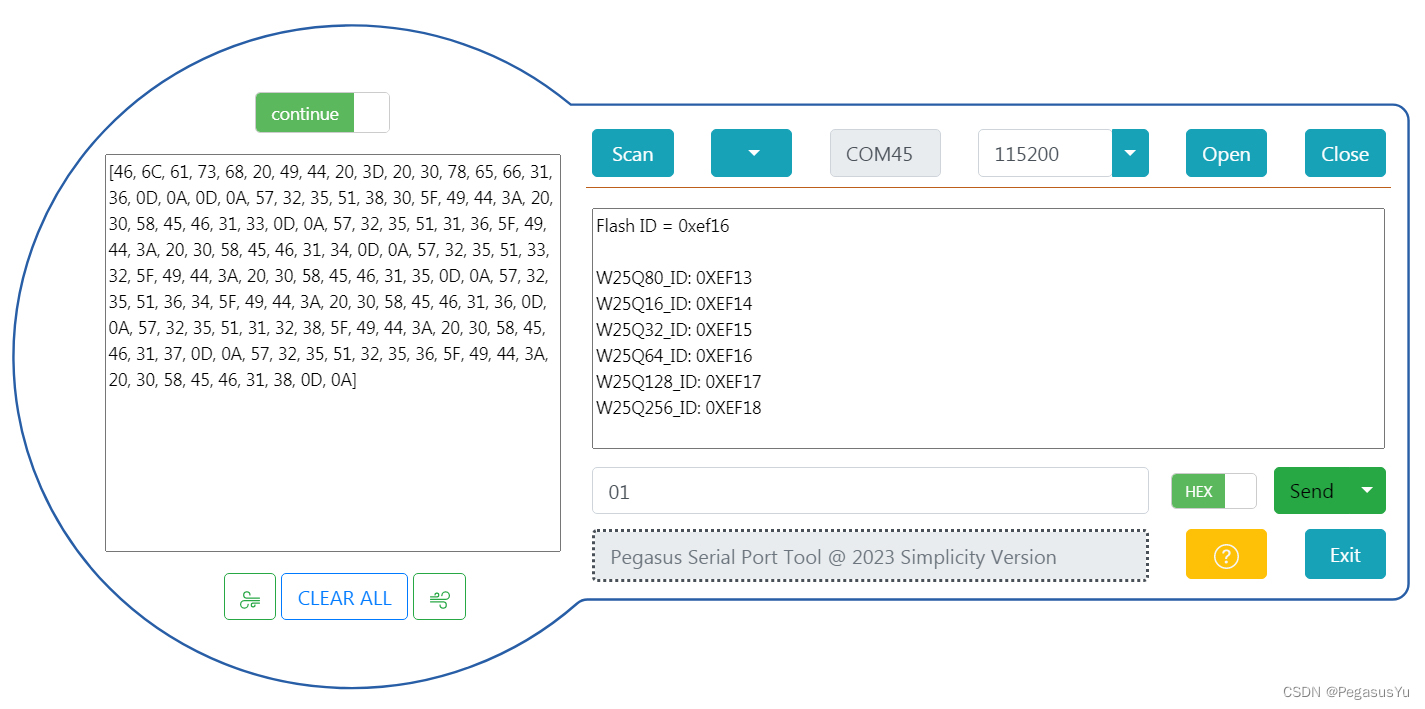
串口指令0x02测试效果如下:
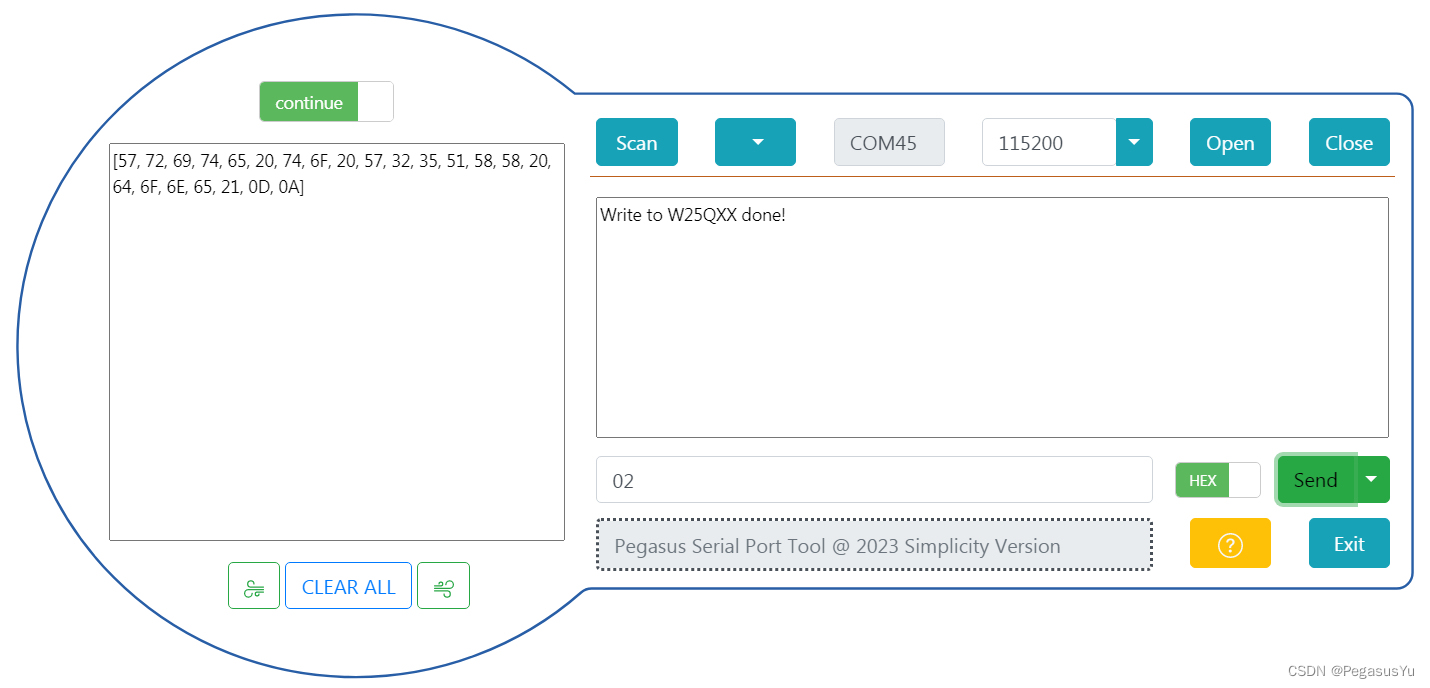
串口指令0x03测试效果如下:
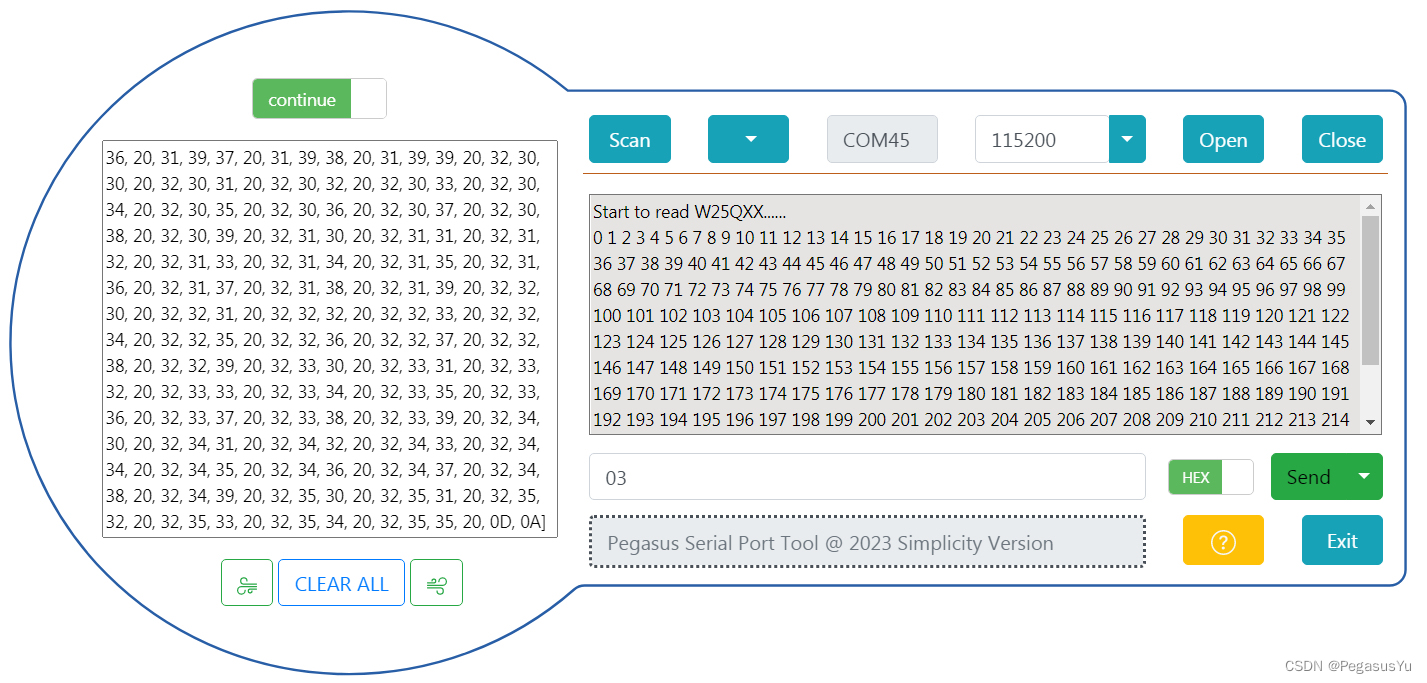
STM32例程下载
STM32H750VBT6 QSPI总线读写FLASH W25QXX HAL库例程下载
–End–

